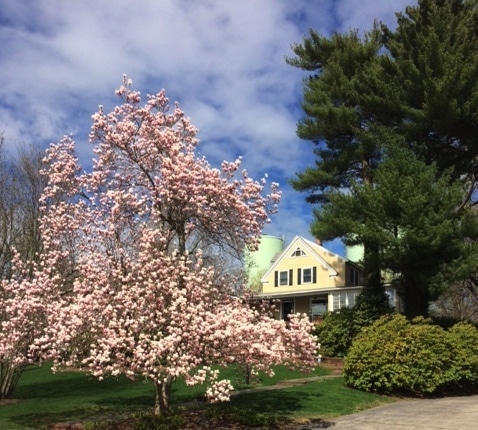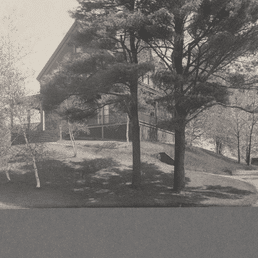 I live an old house. It makes sense: writer, vintage property, high on a hill, seclusion. If the liquor store delivered, I’d never leave. Atmosphere is never in short supply, the house adapting to seasons like a clapboard chameleon. I connected to this house the second I saw it, even after confronted by a kitchen that looked like something the Property Brothers would reject. In its favor was a to-die-for sunroom and built-in character, the kind modern homes can’t possibly produce.
I live an old house. It makes sense: writer, vintage property, high on a hill, seclusion. If the liquor store delivered, I’d never leave. Atmosphere is never in short supply, the house adapting to seasons like a clapboard chameleon. I connected to this house the second I saw it, even after confronted by a kitchen that looked like something the Property Brothers would reject. In its favor was a to-die-for sunroom and built-in character, the kind modern homes can’t possibly produce.
Despite the lures—intangible and otherwise—what I didn’t know was the house’s history. Recorded deeds site conflicting dates: 1900 and 1910 as the year built. At the time of purchase, neighbors-in-the-know and memories were fading fast. No one recalled, with any veracity, its past before the late 1920’s. It didn’t matter. Whatever its history, I was in. Over the years, the house lived up to expectations. I’ve written and sold several novels since living here, wholly inspired by the house on the hill. I’d even go as far as to say the house deserved nearly as much credit as my own imagination.
With that in mind, you might be surprised to learn that recently I discovered I’d been duped. While I’ve been crediting character and gabled rooflines to serving as my steady muse, I should have been thanking Anna Reed Rathbun—my ghostwriter.
Let me explain.

Birch Knoll, circa 1900
Last week, a friend sent a link to an online photo album. Its aged leather cover is engraved Birch Knoll. The family name connected to the album was Rathbun. I’d never heard of either. But with the click of a mouse, I found myself looking into a 125-year old mirror. Exterior photos depict a property that sits on a hilly plot of land unique as a fingerprint. Less the sunroom, which I knew was added around 1940, this was my house. But where were the looming water towers? Behind the property sit two impossible-to-miss water towers, erected in 1888. That would put the year built as prior to either date the deed called out. It was the smallest mystery the photos would reveal.
The album went on with interior pictures, both magnificent and perplexing. Room after room was lavishly embellished, showcasing paintings and rich tapestries, bookcases brimming with novels, mementos that reflected imagination and a rousing sense of adventure. Perhaps most stunning are the nude drawings proudly displayed—shocking for the era certainly. Even the ornate furniture and robust potted plants conveyed how much the people who lived there loved life and their home.
 But at a glance, much of the square footage didn’t make sense, neither did the grandeur. The rooms in these photos were dressed like a manor home, not my period Arts & Crafts abode. It was confounding, but eventually I realized how architectural changes aligned with long-ago photos. This was my house, inside and out. But who were the Rathbuns—a name I’d never heard of? It took some digging to unearth the family, in particular Anna Rathbun. She was a highly accomplished woman for her era and this one. A graduate of Wellesley College, she was schooled in the fine arts, furthering her artistic pursuits in Paris. Apparently, she brought her passion for all art forms into our house, which turned out to be a summer home for the well-to-do Rathbuns of Providence.
But at a glance, much of the square footage didn’t make sense, neither did the grandeur. The rooms in these photos were dressed like a manor home, not my period Arts & Crafts abode. It was confounding, but eventually I realized how architectural changes aligned with long-ago photos. This was my house, inside and out. But who were the Rathbuns—a name I’d never heard of? It took some digging to unearth the family, in particular Anna Rathbun. She was a highly accomplished woman for her era and this one. A graduate of Wellesley College, she was schooled in the fine arts, furthering her artistic pursuits in Paris. Apparently, she brought her passion for all art forms into our house, which turned out to be a summer home for the well-to-do Rathbuns of Providence.
So do I now believe my lovely house is haunted? Not at all, at least not in the chain-rattling, traditional sense. From what I’ve learned about Anna, she doesn’t seem the type to pursue anything so pedestrian. But if muses do exist and creativity is energy, I can only have benefitted from her legacy. That and I stand corrected in attaching inspiration to brick and mortar. My attraction, my connection to the property doesn’t have nearly as much to do with a house as it does the person who lived in it.
